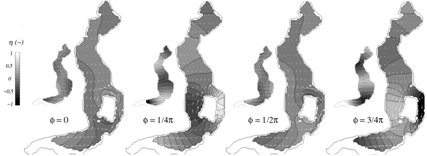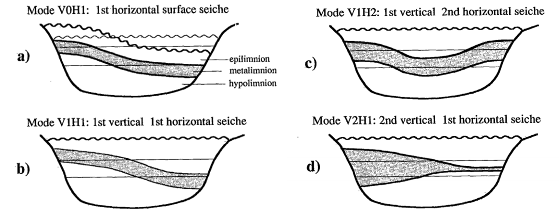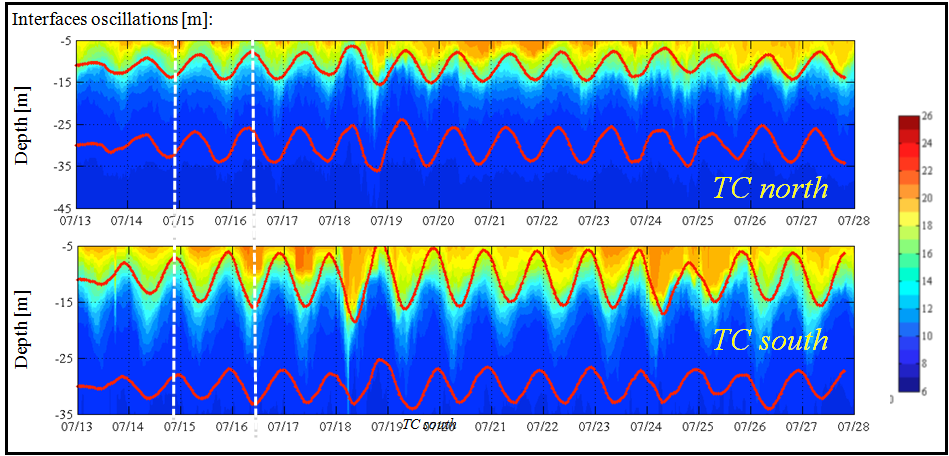Ph.D.Thesis
MEASUREMENT, ANALYSIS AND MODELLING OF INTERNAL WAVES PROPAGATION IN ISEO LAKE
Ph.D. student: Eng. Giulia Valerio
Supervisor: Prof. Eng. Marco Pilotti
ABSRACT
This Thesis addresses the problems and challenges related to monitoring and modelling the propagation of internal waves in a deep lake in northern Italy. Iseo lake is a critical environmental case, whose internal hydrodynamics hasn’t investigated jet. Accordingly, in order to provide the basis of knowledge for future remediation strategies, the research dealt with experimental, theoretical and numerical aspects regarding the main oscillatory motions in Iseo.
The experimental data were obtained by means of a field measuring campaign started in January 2009 that led to the installation of a stations network that assured a continuous and autonomous monitoring of the main physical parameters that control Iseo hydrodynamics. Once analyzed, these data provided the basis for the development of the modelling activity. The numerical results are discussed in comparison with theoretical analyses and field data. Altogether, they yielded the comprehension of the horizontal and vertical structure of the internal modes in a complex natural basin, and the reproduction of the basin-scale oscillations induced by a spatially-varying wind.
This Thesis was developed within a scientific collaboration project with the Centre for Water Resources of the University of Western Australia, where I was a visiting student in 2010 (http://www.cwr.uwa.edu.au/news/index.php?id=2258).
SCIENTIFIC QUESTIONS:
Which type of movements occur in Lake Iseo during the stratified season?
How does the complex morphology of Iseo lake influence the structure of internal waves
METHODS -FIELD EQUIPMENT:
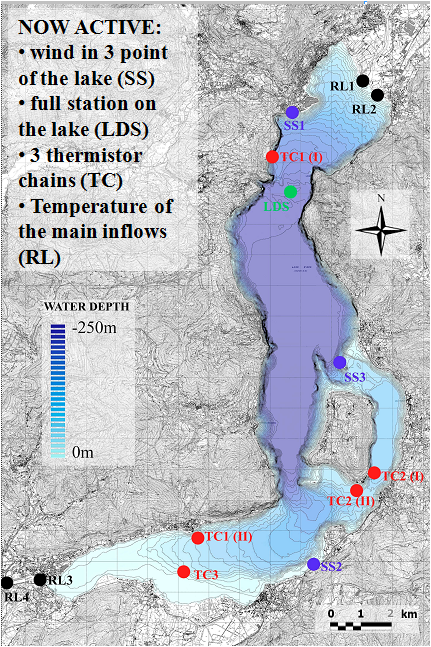 In the period 2009-2011 we have selected and installed a set of instruments in order to assure a continuous and autonomous monitoring of the main physical parameters that control Iseo lake hydrodynamic. This network includes:
In the period 2009-2011 we have selected and installed a set of instruments in order to assure a continuous and autonomous monitoring of the main physical parameters that control Iseo lake hydrodynamic. This network includes:
• An on-lake complete meteorological station (Lake Dignostic System, LDS in the following) that measures the main thermal, radiative, and mechanical fluxes 2m above the water level (wind speed and direction, short wave incoming radiation, total net radiation, relative humidity, air temperature) and the water temperature at 21 different depths along the water column below the station;
• Thermistor chains (TC) that measure the water temperature at different depths;
• Wind stations (SS) located at the lake shore that measure wind speed and direction, atmospheric pressure and air temperature;
• River loggers (RL) that control the incoming and outgoing thermal fluxes by measuring the water temperature of the main inflows and outflows.
METHODS – NUMERICAL MODEL:
The basin-scale internal waves in Lake Iseo were numerically simulated using the layered, modal model developed by the Center for Water Research of the University of Western Australia. Despite the strong simplification operated in the vertical density stratification, in fact, these models can operate in a computationally efficient way on a 3D arbitrary bathymetry. In addition, thanks to the separation of the whole solution into individual modes, they can provide a useful interpretation key of the internal waves structure in relation to the forcing acting on the lake.
Thermal stratification that develops during summer months lasts for time periods which are generally large in comparison to the characteristic processes of internal wave dynamic. On the basis of this separation of scales, the density profile of the water column can be kept constant in time and used to subdivide stratified fluid flow in a lake domain into a finite number of horizontal layers, stacked one upon another and each having a uniform density and separated by interfaces. The motion in this layered system manifests itself as perturbations ηi about the stable state of rest with no deformation at the free and interfacial surfaces that may be described by the equation that express the mass and momentum balance in the rotating frame of reference on the basis of the linear, hydrostatic, Boussinesq and layer approximation. The assumption of a simple harmonic dependence with exponential decay on time of the state vector of motion reduces the solution of the free baroclinic oscillations to an eigenvalue problem, that provides the frequency, damping rate and spatial structure of a set of possible components of lake motions, called free modes. Which of these natural modes are brought into play during any particular disturbance depends on the period and the spatial distribution of the applied force, solvable through the numerical solution of first-ordinary differential equations as a function of time only.
RESULTS – ANALYSIS OF MEASURED DATA
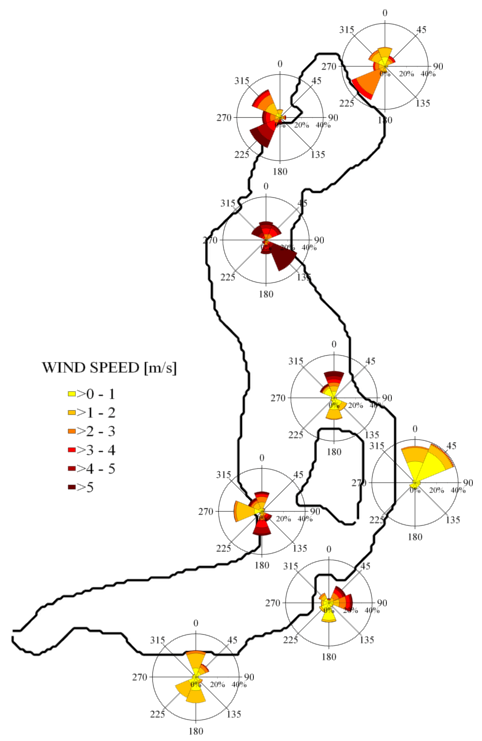 From the analysis of wind data it emerged that the complexity of the topography surrounding the lake generates an high degree of spatial variability on the wind field both in time and space.The interpretation of most of the effects of the spatial variability, such as the deflection due to the valley morphology, the sheltering induced by 3D obstacles and the wind fetch, where supported by a literature review and by simplified numerical simulations of the wind pattern. Water hydrodynamic modelling, on the other side, highlighted the deep influence that these wind pattern have on the mixing processes occurring in the upper water layer, so legitimating the modeling choice of a temporally and spatially varying wind field, reconstructed through the interpolation of the wind data available at the different lake locations.
From the analysis of wind data it emerged that the complexity of the topography surrounding the lake generates an high degree of spatial variability on the wind field both in time and space.The interpretation of most of the effects of the spatial variability, such as the deflection due to the valley morphology, the sheltering induced by 3D obstacles and the wind fetch, where supported by a literature review and by simplified numerical simulations of the wind pattern. Water hydrodynamic modelling, on the other side, highlighted the deep influence that these wind pattern have on the mixing processes occurring in the upper water layer, so legitimating the modeling choice of a temporally and spatially varying wind field, reconstructed through the interpolation of the wind data available at the different lake locations.
The analysis of water temperature data during summer 2010 provided the time series of the isotherm depths. They highlighted the presence of a very energetic and regular motion in the first 50m of the water column, characterized by 5m of vertical displacement/day under ordinary conditions. This motion is characterized by a diurnal periodicity with vertical displacements in phase over the different depths (indicating that most of the motion had a vertical mode one V1 structure); the displacements observed at the southern occurred in counter phase with respect to the northern one, suggesting a horizontal H1 structure. Thus, field data shown the dominance of a V1H1 modal response. Only occasionally, under the action of long-lasting wind events, the Tchains also highlighted the presence of the low frequency oscillation of the metalimnion thickness that occurred out of phase with respect to northern and southern T-chains, suggesting the occasional occurrence of a V2H1 motion.
RESULTS – COMPARISON BETWEEN SIMULATED AND MEASURED INTERNAL WAVE MOTION
The modal code was used to reproduce the internal wave motions during the observation period under the action of a temporally-spatially varying wind field. The modal code showed good capabilities in the reproduction of the main features of both the spatial and temporal structure of measured internal waves. Generally, a very good simulation of the V1H1 metalimnion interfaces oscillations, in term of phase and amplitude, was achieved under ordinary daily winds, so confirming to be the dominant oscillatory response of Iseo lake. The model was also able to reproduce oscillations of longer period, occasionally measured at the lower interface of the metalimnion. In the following figures , an example of comparison between measured and simulated internal waves is provided.
Further, the model helped in understanding the reasons of the occurrence of the observed motions. The analysis of the seasonal evolution of the thermal regime in relation with the wind one, allowed to interpret these oscillatory features as the consequence of a quasi-resonant condition between wind and wave motions. Operating a separation of the whole solution into individual modes, it was possible to interpret occasional long-period motions as second vertical mode oscillations excited by exceptionally strong or long-lasting wind events. It is of real interest to underline how in Iseo Lake the changes induced in heat distribution in time and depth yields in turn to a seasonal evolution of the uninodal free motions periodicity that keeps it in resonance with the wind for the main part of the stratified period.
EVIDENCE AND INTERPRETATION OF THE MODE TRAPPED BY THE ISLAND
With regards to the horizontal structure of the free modes, a key finding was the role played by the peculiar Iseo lake topology. There exist an horizontal mode which is characterized by a wave rotating anticyclonically around Monte Isola perimeter, and so it is strictly linked with the Iseo bathynetry. The presence of this particular oscillatory motion close to the main island has been observed from an experimental point of view and explained theoretically. As a matter of fact, the temperature data measured close to the island gave experimental evidence of the presence of this oscillatory motion; the numerical solution, then, well fitted the main features of both the amplitudes and velocity structure of the anticyclonic solution derived analytically for an annulus-shaped basin. On the basis of these considerations, it was possible to conclude that, when an horizontal mode with a wavelength close to the island radius develops, a Poincarè-like wave is trapped around the island itself.
